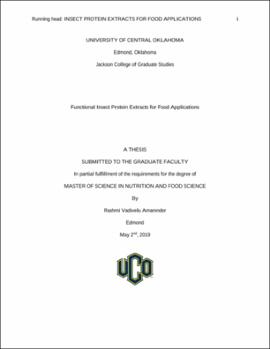| dc.contributor.advisor | Bhargava, Kanika | |
| dc.contributor.author | Vadivelu Amarender, Rashmi | |
| dc.date.accessioned | 2020-07-09T14:41:01Z | |
| dc.date.available | 2020-07-09T14:41:01Z | |
| dc.date.issued | 2019 | |
| dc.identifier.other | (AlmaMMSId)9982665883102196 | |
| dc.identifier.uri | https://hdl.handle.net/11244/325105 | |
| dc.description.abstract | Entomology, or the consumption of insects has been extensively accepted worldwide but is uncommon in the United States. There has been positive research on the sustainability, renewability, nutrition and safety of crickets as food. Due to the current trend of an increasing human population, food security has become a challenge worldwide, especially in developing countries. Studies on crickets as a protein source are still limited. Hence, a thorough investigation of crickets as an alternate insect protein source and incorporation of cricket proteins into low nutrient foods, such as breads and pasta, can help improve the nutritional content and food security. This study aimed to extract the proteins from defatted cricket powder, study its functional properties, incorporate the protein extract into pasta and carry out product analysis. In this research, proximate analysis of fresh cricket powder was studied and is proven to contain 63.43% protein, 20.86% fat, 4.65% ash, 7.56% carbohydrates, 3.50% moisture and 472Kcal/100g. Due to the high-fat content present in the powder, defatting was carried out using hexane and ethanol, reducing the fat content from 20.86% to 9.27% by rotary evaporation. Extraction of proteins was carried out using NaOH and ascorbic acid, ascorbic acid gave the highest yield of 87.75%. The defatted protein extract using ascorbic acid was a good source of essential amino acids having an overall protein content of 69.69%. Nutritional and functional properties of the protein extract were studied for further product formulation and analysis like color, texture, water activity, cooking quality, shelf life study and sensory evaluation. Results demonstrated that insect protein extracts helped improve the nutritional content of freeze-dried pasta thus offering an alternative protein source to the food industry. | |
| dc.rights | All rights reserved by the author, who has granted UCO Chambers Library the non-exclusive right to share this material in its online repositories. Contact UCO Chambers Library's Digital Initiatives Working Group at diwg@uco.edu for the permission policy on the use, reproduction or distribution of this material. | |
| dc.subject.lcsh | Entomophagy | |
| dc.subject.lcsh | Nutrition | |
| dc.subject.lcsh | Sustainability | |
| dc.subject.lcsh | Food security | |
| dc.title | Functional insect protein extracts for food applications. | |
| dc.type | Academic theses | |
| dc.contributor.committeeMember | Holmes, Tawni | |
| dc.contributor.committeeMember | Gamagedara, Sanjeewa | |
| dc.thesis.degree | M.S., Nutrition and Food Science | |
| dc.subject.keywords | Entomophagy | |
| dc.subject.keywords | Food security | |
| dc.subject.keywords | Insect proteins | |
| dc.subject.keywords | Nutrition | |
| dc.subject.keywords | Sustainability | |
| dc.identifier.oclc | (OCoLC)1111736228 | |
| uco.group | UCO - Graduate Works and Theses::UCO - Theses | |
| thesis.degree.grantor | Jackson College of Graduate Studies. | |
